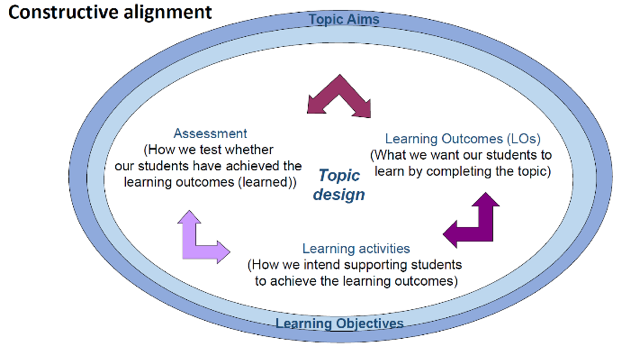The basic principles of developing assessment apply whether you are designing it for online or face to face classes. It is essential to ensure your assessments are linked to the learning outcomes of your topic as well as the material and resources you present to students.
The principle of Constructive alignment is a simple starting point, that is, the alignment of our teaching and learning activities and assessment methods with stated learning outcomes.

Based on the work of Biggs (2005), other similar images exist elsewhere
Ensure your assessments are as authentic as possible and support students’ development of knowledge, experience and skills. Ideally, the assessments will help students learn skills and practices that will be useful when they are in the workforce or further along in their university career. The ACODE eAssessment recommendations may help with some of your planning. As with other teaching, it is only once you are clear about what you want to assess that you can determine how to assess it.
There are a range of tools available in FLO that may be used for either summative or formative assessments, with excellent supporting resources via FLO help. It is important to choose the right tool for the type of assessment (or assignment) you are planning.
Excellent tools to check how students are progressing (formative assessments) include:
- Touch point surveys provide an opportunity to get an idea of whether students are keeping up. It is useful to include one or two across your FLO site.
- Quizzes can vary from multiple choice, short answer, matching etc. They may be used for both formative and summative assessments and can be self-graded or graded by you. It is important to ensure your quiz is well designed to help students learn.
Tools to determine if students have understood all relevant content (summative assessments) include:
- Blogs can be set up by you and require students to contribute. Useful discussion on various forms of content can be posted by you, then responded to by students.
- Forums are useful for asynchronous discussions and commentaries. You may request students to comment on each other’s posts. They are also great for reflecting on readings or other content.
- Quizzes (as above) but with questions which require a grasp of more complex or complete understanding.
- Wikis allow students to create content related to your topics across a range of pages in groups or individually.
- Mahara e-Portfolio (particularly useful for students on placement), is a complete online platform that allows students to tell a story about their learning and progress.
There are also the usual assessments (reports, essays, reflections etc.) which students can upload into FLO for you to mark using your marking guides, rubrics and gradebook which helps you provide results to students.
For further recommendations about assessment online look at the Teaching online guidebook: Assess and give feedback online.
References:
Biggs, J. (2005). Aligning teaching for constructing learning. Higher Education Academy.
Sankey, M. (2020). Teaching online in the current crisis: what you need to know. Campus Morning Mail.
Written by Ann Luzeckyj
Senior Academic Developer – CILT

